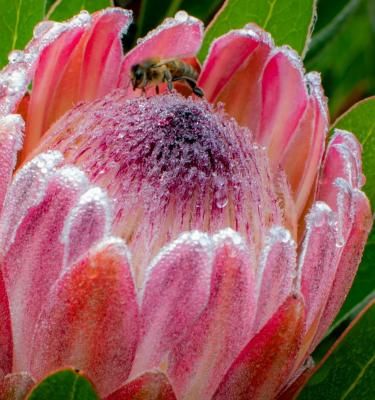

How to grow & care for proteas
Proteas are sun-loving beauties originally from South Africa, that grow particularly well in our poor Australian soils.
Proteas love the same conditions as many Australian native plants and are perfect for low maintenance or low water use gardens. You can grow them in small or large gardens and even pots. Their flowers and foliage provide year-round colour and they make a long-lasting cut flower.
Top 5 steps to growing proteas
- Although they are native to South Africa, Proteas thrive in similar conditions to Australian native plants.
- Choose a full sun spot with a free draining soil.
- Proteas should only be fed with a fertiliser that’s suitable for natives such as Scotts Osmocote® Plus Organics All Purpose (including Natives) Plant Food & Soil Improver or Scotts Osmocote® Controlled Release Fertiliser: Native
- Remove spent flowers to encourage new bushy growth.
- Proteas grow well in pots or containers - use a native suitable potting mix like Scotts Osmocote® Native Potting Mix
Shopping List
- A protea plant, choose a variety to suit your garden space and size.
- Scotts Osmocote® Compost Premium Soil Improver
- Scotts Osmocote® Plus Organics All Purpose (including Natives) Plant Food & Soil Improver
- Garden Shovel
- If growing in pots, you’ll need Scotts Osmocote® Native Potting Mix and Scotts Osmocote® Controlled Release Fertiliser: Native plus a suitable pot or container
Preparation
Proteas prefer a loose, sandy or sandy loam soil. If you’ve got a lot of clay - mound up the soil and mix gypsum plus some Scotts Osmocote® Compost Premium Soil Improver through the area before planting to help improve drainage.
Most proteas prefer a soil with a pH around 5.5, but some varieties will tolerate a more neutral pH. Check with your local nursery or garden centre on varieties that will work in your climate and soil conditions.
Planting in the garden
Plant your protea into prepared soil - dig the hole twice as wide as the original pot and the same depth. Gently remove the protea from the nursery pot, tease roots if they are compact and plant into the hole. Back fill around the plant and water in well.
Mulch around the base of proteas to retain moisture and suppress weeds, but keep the mulch away from the main stem.
When your proteas are young they’ll need watering up to twice a week throughout their first summer, and maybe more in extreme heat.
Planting in pots
Proteas can be grown in medium to large pots or planters with good drainage - choose a pot that’s 2 to 3 times bigger than the original nursery pot. You can always upgrade to bigger pots as your protea grows bigger. To improve the drainage if needed drill more holes in the base of your pot or raise it off the ground with small pot feet.
Fill your pot or planter with Scotts Osmocote® Native Potting Mix. Gently remove the protea from the nursery pot, tease the roots if they are compact and plant into the potting mix at the same height it was in the original pot. Back fill around the plant with more potting mix and water in well.
Mulch over the surface of the potting mix to help retain moisture, but keep the mulch back from the plants main stems.
Fertilising & Care
An annual feed in late winter with Scotts Osmocote® Plus Organics All Purpose (including Natives) Plant Food & Soil Improver is all most proteas will need. Unless you have a very sandy soil, which might require a second annual fertiliser application.
As well as removing spent flowers throughout the flowering season, a tip prune in spring or late summer is all the pruning young protea plants need. More established proteas should be pruned back to leave about 10cm of growth on the stems that flowered - leave stems that haven’t flowered to continue growing for next season.
Fertilise potted proteas with Scotts Osmocote® Native Potting Mix and Scotts Osmocote® Plus Organics All Purpose (including Natives) Plant Food & Soil Improver and repot them every 1 to 2 years with fresh Scotts Osmocote® Native Potting Mix - going up a pot size if needed.
Pests & Diseases
Proteas are relatively pest free but scale can sometimes be a problem - spray any infestations with Defender™ Pyrethrum Insect Spray as needed.
Root rot can easily occur if proteas sit in a waterlogged soil or potting mix. Ensure good drainage to prevent this from happening.



